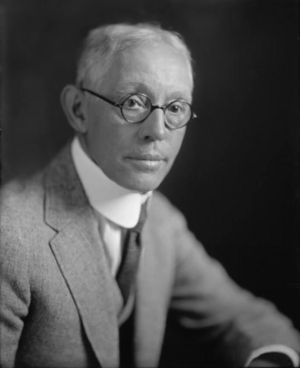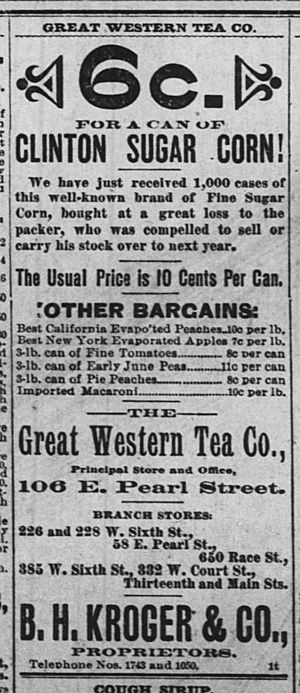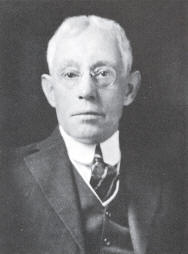Bernard Kroger facts for kids
Quick facts for kids
Bernard Kroger
|
|
|---|---|
 |
|
| Born |
Bernard Heinrich Kroger
January 24, 1860 Cincinnati, Ohio, U.S.
|
| Died | July 21, 1938 (aged 78) |
| Resting place | Spring Grove Cemetery, Cincinnati |
| Occupation | Grocer, entrepreneur, banker, philanthropist |
| Known for | Kroger |
Bernard Heinrich "Henry" Kroger (born January 24, 1860 – died July 21, 1938) was an American businessman. He is famous for creating the Kroger chain of supermarkets. Kroger was a pioneer in the grocery world. He was one of the first to let customers shop for themselves in his stores. This was called "self-service" shopping, and he started it in 1895. Before this, people usually waited for staff to get their items. Kroger also made sure prices were clearly shown on every item.
His stores were also the first to sell freshly baked goods, meat, and groceries all in one place. This made shopping much easier for people.
Contents
Early Life and First Jobs
Kroger was born in Cincinnati, Ohio. He was the fifth of ten children. His parents, Johan Heinrich and Mary Gertrude Kroger, were immigrants from Germany. They owned a dry goods store, and the family lived above it.
When Kroger was 13, his parents' store had to close because of money problems in 1873. Kroger quit school to help his family. His first job was at a drug store, but he left because his Christian mother didn't want him working on Sundays.
Next, he worked as a farmhand near Pleasant Plain, Ohio. He earned six dollars a month. Kroger later said, "I shall never forget that first night I spent away from home." He was only 14 and weighed 100 pounds, but he did the work of a grown man. He didn't like his boss and got malaria. So, he quit and walked 37 miles back to Cincinnati.
Family Life
Bernard Kroger married Mary Emily Jansen. They had seven children together. Sadly, both his oldest son and his wife Mary passed away in 1899.
Starting a Grocery Empire
Kroger then became a door-to-door salesman for a tea company. He later worked at the Imperial Tea Co. This grocery store was not doing well. The owners made Kroger the manager. He quickly turned the store around, making a good profit. But when the owners wouldn't make him a partner, Kroger decided to start his own business.
He used his life savings of $372 and teamed up with a friend, B.A. Branagan. Branagan borrowed $350. Together, they opened a grocery store at 66 Pearl Street in downtown Cincinnati. But a big flood in 1884 ruined their store overnight. They didn't give up and opened another one.
Kroger called their stores "B.H. Kroger & Co., proprietors of The Great Western Tea Co." The stores did well. Kroger wanted more control, so he bought out Branagan's share. Soon, he opened four more stores in Cincinnati.
Grocery Innovations
Kroger is known for creating the successful idea of low-cost, self-service grocery stores that we still see today. Here are some of his big ideas:
- He was the first grocer to put the sale price on every single item.
- He started giving a special gift or "premium" to customers who bought coffee or tea.
- In 1902, he started a "profit-sharing" system. Customers collected receipts ("proofs of purchase") and could trade them for useful items like dishes, rugs, or lamps.
- In 1912, Kroger was the first grocer to use cars for deliveries. He bought 75 Ford Model Ts, replacing 200 horses and wagons in Cincinnati.
- He was a pioneer in putting a bakery and later a fresh meat market inside his grocery stores.
Smart Advertising and Quality Control
Kroger believed that advertising was key to his success. As early as 1895, he advertised a lot in local newspapers. His ads listed many items for sale, often filling entire pages. This was a new and big marketing effort back then. He always included "money-saving prices" in his ads.
To control costs and quality, Kroger bought products in large amounts and paid suppliers with cash. This helped him get better prices. He also started making many of his own "private label" products. By 1902, he had a factory making his own brands of preserved foods, jellies, and crackers.
Kroger was also the first grocer to have a special lab to check the quality of his products (in 1921). He also used scientific research to understand what customers wanted.
Fair Prices and Growth
Kroger was good at showing customers that his prices were fair. For example, in 1902, when coal prices went up, he didn't raise the price of his bread. He explained that the cost increase per loaf was very small.
Kroger kept opening new stores. In the 1890s, he expanded into Kentucky. In 1902, he bought 14 grocery stores in Dayton, Ohio. Kroger stores appeared in Missouri in 1912 and Indiana in 1924. By 1929, Kroger had grown to a huge 5,575 stores!
Shorter Store Hours
In 1899, Kroger suggested that all grocery stores should close by 7:00 pm. He said he wanted to give working people their evenings free. He set the 7:00 pm closing time so that people who finished work at 6:00 pm still had an hour to buy their groceries.
Company Growth and Sale
By 1904, Kroger's company was so successful that he made it a corporation. He sold stock worth $1,000,000 to public investors. He kept most of the shares for himself. The company was renamed "Kroger Grocery & Baking Co." Later, it was simply called "Kroger".
Kroger was the first to put fresh meat departments inside U.S. grocery stores. In 1904, he bought a meat packing company. This allowed him to offer fresh meat directly in his stores. He even advertised certain cuts of meat on specific days to attract more customers.
By 1905, Kroger also offered telephone orders. Customers could call their nearest Kroger store, and their orders would be filled carefully. Kroger ads even told homeowners that if they gave their phone number, the store would call them every morning for their order.
By the late 1920s, Kroger had bought and opened over 5,500 stores. In December 1927, he sold the company for $28,000,000 to a group of bankers. He stepped down as president of the Kroger Co. in 1928 and left the company's board of directors in 1931.
Other Business Ventures
Kroger was not just a grocer. He also got involved in banking and transportation.
Banking
In 1900, Kroger helped start the Provident Savings Bank. He became the bank's president in 1904. He worked to make the bank grow. He sold his shares in the bank in 1928, just before the Wall Street Crash of 1929. During a bank crisis in 1933, he showed $15 million of his own cash at the bank. This helped prove the bank was financially strong and prevented a local crisis. He was the chairman of the bank's board when he died.
Transportation
Kroger also tried to make money from public transportation. He bought the rights to build a commuter rail line in Cincinnati. By 1903, he was president of the Cincinnati, Milford and Loveland Traction Company, also known as "The Milford Line." He built a 17-mile electric train line.
The service started on March 28, 1904. People called it the "Kroger Line" or the "Blue Line" because the cars were royal blue. The trains were praised for their comfortable heating and polite conductors. The line even had separate smoking areas. Kroger later extended the line further.
However, the line faced many problems. Electricity was expensive and unreliable, and the old cars caused accidents. The company went bankrupt in 1919, and the last train ran on December 31, 1919.
Running for Governor
On June 29, 1912, a group of Cincinnati businessmen asked the Republican Party to nominate Kroger as their candidate for governor of Ohio. News articles said they wanted Kroger because he was "a clean man" and it was "time for a business man to conduct the business affairs of the state." Kroger said he would accept if nominated because "the conditions in the state of Ohio are ripe for a business administration."
However, Kroger lost the nomination at the convention. After several votes, another candidate, Judge Edmond B. Dillon, was chosen instead.
Helping Others (Charitable Efforts)
Kroger was very involved in charity work. He helped open parks, donated to zoos, and supported medical research. He helped many organizations, including the Cincinnati Institute of Fine Arts and the Community Chest. A newspaper columnist once said Kroger told him, "You meet a great many people who need help. If I can be of service, let me know."
Support for the Blind
In 1911, Kroger became president of the Cincinnati Welfare Association of the Blind. He and another philanthropist each promised $1,000 per year. Kroger immediately funded a factory where blind adults could make brooms and mops. Kroger sold these products in his stores and gave all the money from sales to the Welfare Association.
Helping Children with Illnesses
Kroger was a big supporter in Cincinnati's fight against childhood tuberculosis and anemia. He helped fund the Kroger Hills Camp for Anemic Children. This camp was on 92 acres and allowed children with these illnesses to get fresh air, exercise, and medical care during the summer. In 1916, Kroger offered to help raise money to double the camp's size. By 1922, the camp helped nearly 500 children each summer.
Community Donations
In 1934, Kroger donated five tigers to the Cincinnati Zoo for their new Tiger Grotto. This was one of the first "barless" exhibits at the zoo, meaning it didn't use traditional bars to separate animals from visitors.
Kroger's kindness wasn't just in Cincinnati. The Hyden Hospital and Health Center in Hyden, Kentucky, needed better cows to provide milk for mothers and children. Kroger saw their request in a newsletter and sent a "generous check" to help.
Death and Burial
Bernard Kroger had been in poor health for several years. He died of a heart attack on July 21, 1938, at his summer home in Wianno Historic District, Cape Cod, Massachusetts. He was 78 years old.
His personal wealth was valued at over $8.8 million. He was buried in Cincinnati's Spring Grove Cemetery.
|



